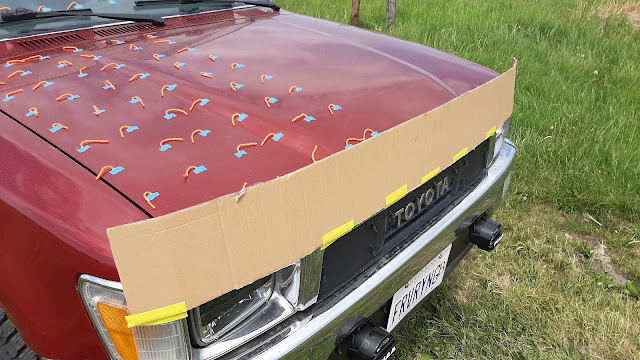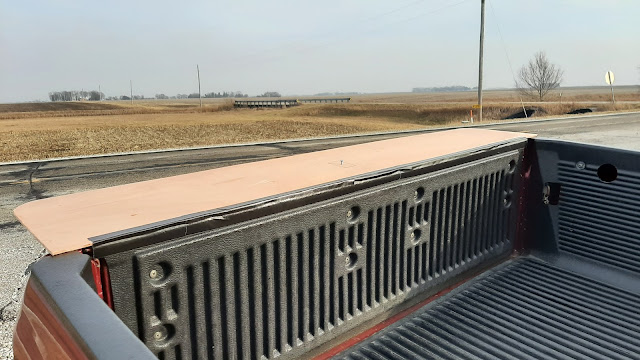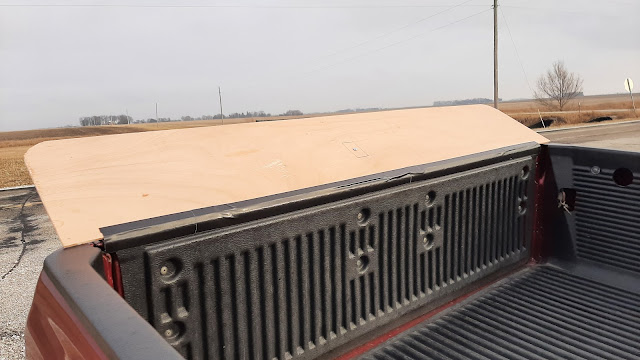Aerodynamic Testing and Modification
#1
Registered User
Thread Starter
Aerodynamic Testing and Modification
Over the past couple of years, I've been fortunate to correspond at length with Julian Edgar, the editor of Autospeed and author of several books on car modification. One of his most recent books deals with aerodynamic modification, and I thought I would apply some of his test techniques to see what happens when I make changes to a truck. I've been documenting all this on my website but here's a synopsis, in case anyone here is curious.
Part 1: Grill Blocking and Mirror Removal

A full grill block and both mirrors removed is worth about 4% reduction in drag.
Part 2: Fenced A-pillar and Bug Deflector

The fenced A-pillar has no effect on the flow over the windshield and side window.

A bug deflector mock-up, however, has a significant effect on the flow over the hood and windshield. Before:

After:

Part 3: Front Spoiler
I tested a front spoiler (air dam) at 2 heights:


The larger dam reduces drag about 9%, and the shorter about 6.5%.
Part 1: Grill Blocking and Mirror Removal

A full grill block and both mirrors removed is worth about 4% reduction in drag.
Part 2: Fenced A-pillar and Bug Deflector

The fenced A-pillar has no effect on the flow over the windshield and side window.

A bug deflector mock-up, however, has a significant effect on the flow over the hood and windshield. Before:

After:

Part 3: Front Spoiler
I tested a front spoiler (air dam) at 2 heights:


The larger dam reduces drag about 9%, and the shorter about 6.5%.
#2
Registered User
Aerodynamic drag comes in several flavors...form drag, parasitic drag, induced drag, etc. How did you determine the drag reductions? Measure with instrumentation? What kind of instrumentation? Curious.
#3
Registered User
Thread Starter
To measure changes in drag on the truck, since it has a mechanical throttle connection I'm able to use throttle-stop testing, a technique developed by Julian. By limiting throttle opening to a constant angle, changes in drag show up as increased or reduced speed, and the percentage change in drag can be calculated by the ratio of the speeds squared. I wired in a throttle position sensor voltage display and use a physical stop under the throttle pedal during testing to ensure constancy. It can't measure very small changes (<2%) if you want to stay at legal speeds; it also can't measure huge changes because then you run into issues of changes in engine speed and power, and potentially variations in rolling resistance with larger changes in speed. But it will give an approximate measure of moderate to large changes in drag. And it costs next to nothing.
#4
Registered User
Thread Starter
I didn't have much time this fall to test more things on the truck but did get some done. Air dam extensions and wheel covers:

Together these reduce drag about 7%.

Together these reduce drag about 7%.
#5
Registered User
I had a bug deflector and it caused the air to loop back towards the front of the hood. It made the wiper blades rattle in rest position. It did add felt down force on the front for better steering. Took it off,
#6
YT Community Team
I had a customer come in one time with a brand new Cressida that was Pearl White Metallic. He bought it, then promptly went home and covered it with green modeling clay to show where Toyota could improve aerodynamics. Then drove it back to us to proudly show off his engineering marvel. I guess He thought the local dealer was his best pipeline to the factory in Japan. Not.
I'm sure most manufacturers are keenly aware of where aerodynamics can be improved. But either for safety or functionality they've opted out of certain designs, depending on the model. Go look at the front bumper on the Tacoma's these days. Much lower than prior generations. Fine for highway, totally sucks off-road. I've had to remove and repair twice.
I'm sure most manufacturers are keenly aware of where aerodynamics can be improved. But either for safety or functionality they've opted out of certain designs, depending on the model. Go look at the front bumper on the Tacoma's these days. Much lower than prior generations. Fine for highway, totally sucks off-road. I've had to remove and repair twice.
Last edited by Jimkola; 12-15-2022 at 04:05 PM.
The following users liked this post:
old87yota (12-14-2022)
#7
Registered User
Thread Starter
I'm sure most manufacturers are keenly aware of where aerodynamics can be improved. But either for safety or functionality they've opted out of certain designs, depending on the model. Go look at the front bumper on the Tacoma's these days. Much lower than prior generations. Fine for highway, totally sucks off-road. I've had to remove and repair twice.
Last edited by Vman455; 01-04-2023 at 02:36 PM.
Trending Topics
#8
YT Community Team
The front air dam is fine, until you get it caught on one of those concrete stops in a parking lot. Or scrape the heck out of it on a driveway with a short, but steep angle. My favorite was trying to explain that we literally couldn't rack the vehicle to lift it in the air to service without using multiple floor jacks to get the front end over the rack.. Sometimes they lowered it to the point that even the floor jacks didn't work.
All that is fine for the person willing to deal with limitations(and hassle) their mod generated, but most car manufacturers aren't going to produce vehicles on a mass scale where those kind of issues are routine.
All that is fine for the person willing to deal with limitations(and hassle) their mod generated, but most car manufacturers aren't going to produce vehicles on a mass scale where those kind of issues are routine.
Last edited by Jimkola; 01-05-2023 at 02:43 PM.
#9
Registered User
Thread Starter
The front air dam is fine, until you get it caught on one of those concrete stops in a parking lot. Or scrape the heck out of it on a driveway with a short, but steep angle. My favorite was trying to explain that we literally couldn't rack the vehicle to in the air to service it without using multiple floor jacks to get the front end over the rack.. Sometimes they lowered it to the point that even the floor jacks didn't work.
All that is fine for the person willing to deal with limitations(and hassle) their mod generated, but most car manufacturers aren't going to produce vehicles on a mass scale where those kind of issues are routine.
All that is fine for the person willing to deal with limitations(and hassle) their mod generated, but most car manufacturers aren't going to produce vehicles on a mass scale where those kind of issues are routine.
#10
Registered User
Thread Starter
Part 5: Tailgate and Spoiler





Tailgate down and a large spoiler at 0, 15, 30, and 45 degrees from horizontal vs. tailgate up with no spoiler. Tailgate down increases drag around 4%; the spoiler increases drag from ~4% at 0 degrees to ~9% at 45 degrees.





Tailgate down and a large spoiler at 0, 15, 30, and 45 degrees from horizontal vs. tailgate up with no spoiler. Tailgate down increases drag around 4%; the spoiler increases drag from ~4% at 0 degrees to ~9% at 45 degrees.
The following users liked this post:
old87yota (01-12-2023)
#11
There's a lot you can do to measure things on the road. Tuft testing to visualize streamlines, direct measurement of aerodynamic pressures, and various methods to measure changes in drag. You can also measure lift using ride height sensors, which Julian has done extensively but I haven't tried yet.
To measure changes in drag on the truck, since it has a mechanical throttle connection I'm able to use throttle-stop testing, a technique developed by Julian. By limiting throttle opening to a constant angle, changes in drag show up as increased or reduced speed, and the percentage change in drag can be calculated by the ratio of the speeds squared. I wired in a throttle position sensor voltage display and use a physical stop under the throttle pedal during testing to ensure constancy. It can't measure very small changes (<2%) if you want to stay at legal speeds; it also can't measure huge changes because then you run into issues of changes in engine speed and power, and potentially variations in rolling resistance with larger changes in speed. But it will give an approximate measure of moderate to large changes in drag. And it costs next to nothing.
To measure changes in drag on the truck, since it has a mechanical throttle connection I'm able to use throttle-stop testing, a technique developed by Julian. By limiting throttle opening to a constant angle, changes in drag show up as increased or reduced speed, and the percentage change in drag can be calculated by the ratio of the speeds squared. I wired in a throttle position sensor voltage display and use a physical stop under the throttle pedal during testing to ensure constancy. It can't measure very small changes (<2%) if you want to stay at legal speeds; it also can't measure huge changes because then you run into issues of changes in engine speed and power, and potentially variations in rolling resistance with larger changes in speed. But it will give an approximate measure of moderate to large changes in drag. And it costs next to nothing.
Last edited by johnvegas; 08-22-2024 at 10:21 AM.
#12
A cover on the bed surprisingly also creates more drag.
#13
Registered User
Thread Starter
Have you considered barometric conditions as a factor. Anyone riding a motorcycle with a full helmet knows that 55 on a bright clear day (high pressure) is harder on the neck muscles than a overcast (low pressure) day. I can only imagine this could account for a sizeable percentage. Guessing 1-5%
When you measure a change in drag this way, the percent change applies no matter the density since the drag force in unmodified and modified conditions are both proportional to density, so it divides out in the ratio of the two.
Last edited by Vman455; 08-24-2024 at 05:54 PM.
Thread
Thread Starter
Forum
Replies
Last Post










